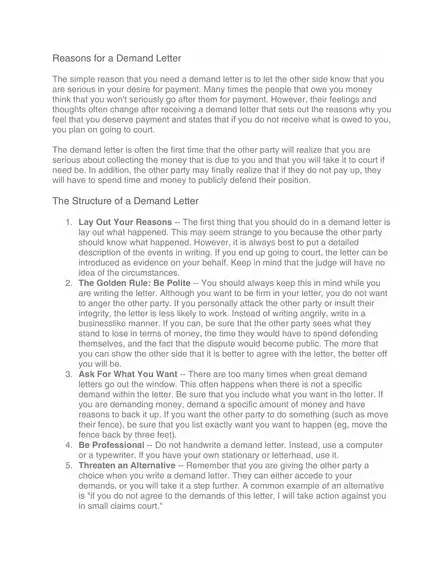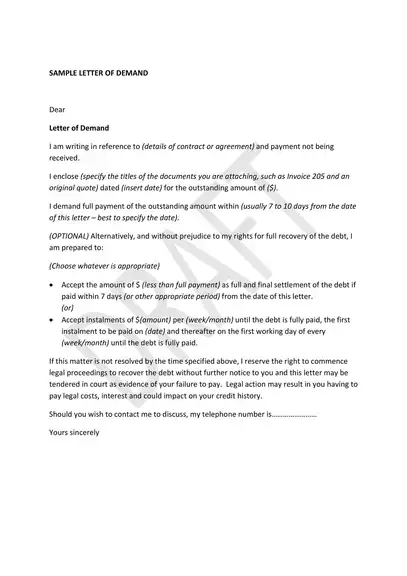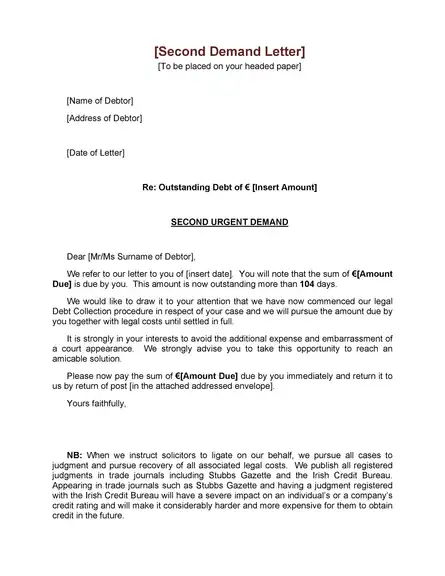Free Sample Demand Letter For Payment – A demand letter is an official document stating a plea to the recipient. Generally, when someone sends you this kind of letter, they request you to accomplish something related to the business you’ve agreed with. When a dispute appears, the document will serve as official evidence supporting your statement in court.
When you face problems with a partner you have a contract with, you don’t need to send a demand letter instantly. You should first communicate it and find the best way to overcome it. However, when you don’t get a proper response and see no good intention from your partner, you can send this legal letter.
The letter will ultimately be beneficial when you have issues with payments or want to get back the money you’ve lent. You may state in the demand letter that you would like to continue the case in court if they don’t pay at a particular time. Here are some rules you have to understand when writing the letter.
Tips for Writing an Effective Demand Letter
A well-crafted demand letter can prompt the recipient to act, while a poorly written one can exacerbate the dispute or even lead to legal complications. Here are some tips on how to make a demand letter more effective:
- Maintain a Professional Tone: The tone should be professional and respectful. Remember, the goal is to resolve a dispute, not to vent your frustrations or provoke the recipient. Avoid using confrontational language. Instead, aim for a tone that is firm but fair.
- Be Specific with Your Demands: It should clearly state what you want the recipient to do. If you seek payment, specify the amount owed, the original due date, and any accrued interest or penalties. If you’re seeking a specific action, describe it in detail. The more specific you are, the less room there is for misunderstanding or evasion.
- Provide Clear Deadlines: Your demand letter should also specify a deadline for the recipient to meet your demands. It creates a sense of urgency and gives you a timeframe for deciding your next steps if the recipient fails to comply. Be reasonable with your deadline; give the recipient enough time to respond, but keep the issue from dragging on for a while.
- Offer Alternatives: Offer alternatives for resolving the dispute. It could be a payment plan for a debt, a meeting to discuss the issue or a suggestion for mediation or arbitration. Offering alternatives shows that you’re flexible and committed to finding a resolution.
- Politeness and Transparency: It is a formal document but still a communication between two parties. Be polite and transparent in your language. Avoid legal jargon and write in a way that’s easy to understand. Make sure your demands are fair and reasonable, and explain why you believe they are justified.
- Proofread and Review: Before sending, take the time to proofread it for errors and review it for clarity and tone. It may be helpful to have a third party, such as a lawyer or a trusted colleague, review the letter.
Writing an effective demand letter requires a balance of firmness and respect. By maintaining a professional tone, being specific with your demands, providing clear deadlines, offering alternatives, and prioritizing politeness and transparency, you can increase the chances of your demand letter achieving its intended result.
Creating a Demand Letter: A Step-by-Step Guide
Creating a demand letter can seem daunting, primarily if you’ve never written one. However, with a clear understanding of its purpose and structure, you can craft a demand letter that effectively communicates your demands and encourages the recipient to act. Here’s a step-by-step guide on how to create a demand letter:
- State the Reasons for the Letter: Begin your letter by clearly stating why you’re writing it. Explain the issue or dispute that has led to this point. Be specific and factual in your description, and avoid emotional or subjective language. This section sets the context for your demands and helps the recipient understand the seriousness of the situation.
- Use Formal Language: A demand letter is a formal document, so it’s important to use formal language. It includes using the recipient’s full name and address, proper salutations and closings, and avoiding slang or informal language. However, keep your language simple and straightforward to ensure the recipient understands your demands.
- Detail Your Demands: Next, clearly state what you want the recipient to do. It could be paying a debt, fulfilling a contractual obligation, or taking other specific actions. Be clear as possible, and include relevant details such as amounts, dates, or activities required.
- Provide a Final Resolution or Alternative: You will accept an alternative or final resolution. It could be a payment plan, a meeting to discuss the issue or a suggestion for mediation or arbitration. Offering an alternative shows you’re flexible and committed to resolving the dispute.
- State the Consequences of Non-Compliance: Clearly state what will happen if the recipient fails to comply with your demands. It could include legal action, reporting to credit bureaus, or other consequences. However, be careful not to make threats or use harsh language.
- Proofread and Review: Finally, proofread your letter for errors and review it for clarity and tone. Ensure your demands are precise, your language is professional, and your tone is firm but respectful.
Creating a demand letter requires a balance of clarity, precision, and professionalism. By clearly stating your reasons, using formal language, detailing your demands, providing alternatives, and stating the consequences of non-compliance, you can craft a demand letter that effectively communicates your demands and encourages the recipient to act.
Remember, the goal of a demand letter is to resolve a dispute, not to escalate it. Always approach the process with a focus on resolution and fairness.
Demand letter template
Here are some rules you have to understand when writing the letter.
- Reasons Statement
It is the very first element of a demand letter. Explain why you are sending this letter and let the recipient know the problem. Explaining the problems in detail and writing all events chronologically are the best way to state your reasons.
You will have strong evidence to bring the case to court. Since the judges will understand your circumstances around the issue clearly, they will likely help you solve it.
- Formal Language
When writing demand letters, you should stay professional and use formal language. Even if you feel irritated and have many things in your head, you should still be polite and avoid insulting your reader. Don’t let your emotions take over you, or this letter won’t work.
Show the recipient that you are a professional by using a formal tone in your demand letter. Polite language won’t make the recipient feel wrong about the letter. You also need to avoid handwriting and prefer for computer or typewriter to compose it.
Let them know what will happen if they won’t act by the letter. With this transparency and politeness, the letter will be more effective than you think.
- Demands
Besides the reasons, you should also focus on the demands themselves. You should write this section of the demand letter in a specific and detailed way, so the reader will know what you expect from them.
If you write this letter to request payment, you should state its specific amount. If you demand its recipient to perform certain tasks, you can list it all in detail.
- Provide Final Resolution or Alternative
After demands, you can continue your demand letter with a request or alternatives to resolve the issue. Regarding getting back money owed or payment, you should state the deadline.
You can also arrange an alternative if they can only complete the tasks after the deadline. End your demand letter with consequences they should face if demands are not fulfilled.

Different Types of Demand Letters
The basic structure remains the same. The content and tone can vary depending on the circumstances. Here, we will explore the different types that are commonly used.
- Payment Demand Letter: It is the most common type. It is used when a debtor has failed to pay a debt by the due date. The letter will state the payment owed, the original due date, any interest or penalties accrued, and a new deadline for payment.
- Breach of Contract Demand Letter: It is used when one party fails to fulfil their contractual duties. The letter will detail the nature of the breach, the steps required to remedy the breach, and the results of failing to do so.
- Personal Injury Demand Letter: If a person has suffered a personal injury due to someone else’s negligence, they may send a demand letter to request compensation. The letter will describe the injury, explain why the recipient is liable, and demand a specific amount in damages.
- Cease and Desist Letter: This type of demand letter stops harmful behaviour. It could be used, for example, to stop harassment, to end copyright infringement, or to halt defamation. The letter will explain the dangerous behaviour, why it is illegal or damaging, and demand that it stop.
- Insurance Claim Demand Letter: It formally requests compensation for a covered loss to an insurance company. The letter will detail the nature of the loss, the coverage under the policy, and the amount being claimed.
- Property Damage Demand Letter: If a person’s property has been damaged due to someone else’s actions, they may send a demand letter to request compensation. The letter will describe the damage, explain why the recipient is liable, and demand a specific amount.
The primary purpose of a demand letter remains the same – to request action or compliance – the specific type of demand letter used can vary depending on the situation. Understanding the different types of demand letters can help you choose the right approach for your circumstances.
When to Use a Demand Letter
A demand letter is a formal document often used as a last resort to resolve disputes or claim unpaid debts. It is a powerful tool to help you assert your rights and protect your interests. However, knowing when to use a demand letter is crucial to its effectiveness. The appropriate situations are to use a demand letter and escalate an issue to a demand letter.
Appropriate Situations for a Demand Letter
It is typically used when a dispute has arisen, and previous attempts at resolution have been unsuccessful. Here are a few scenarios where a demand letter might be appropriate:
Unresolved Issues with a Business Partner: If you’re facing ongoing issues with a business partner that still need to be resolved through regular communication, It can serve as a formal request for resolution. It could include disputes over contract terms, business operations, or other conflicts impacting the business relationship.
- Delayed Payments: An everyday use is to request payment for overdue debts. If a client or customer has yet to pay their invoices on time, It can serve as a formal request for payment. It can outline the amount owed, the due date, and non-payment consequences.
- Breach of Contract: If someone has breached a contract, whether a business contract, a lease agreement, or a service contract, a demand letter can be used to request compliance or seek damages.
- Property Damage: If your property has been damaged and the responsible party refuses to pay for repairs, a demand letter can be used to demand compensation.
Escalating an Issue to a Demand Letter
Before you resort to sending, attempting to resolve the issue through other means is essential. Here is a general process you can follow:
- Initial Communication: Start by communicating the issue directly with the other party. It could be through a phone call, an email, or a face-to-face meeting. Be clear about the case, your expectations for resolution, and the timeframe in which you expect it to be resolved.
- Follow-up Communication: Follow up with the other party if the issue still needs to be resolved in the initial timeframe. Reiterate the issue and your expectations for resolution.
- Assessing the Other Party’s Response: If the other party is unresponsive, dismissive, or unwilling to resolve the issue, it may be time to escalate the matter.
- Writing the Demand Letter: At this point, you can begin to draft your demand letter. Be sure to include all relevant details, such as a clear explanation of the issue, a summary of previous communication attempts, your specific demands, and the legal consequences of non-compliance.
- Sending the Demand Letter: Once your letter is complete, send it to the other party via certified mail. It provides proof that the letter was received.
By understanding when to use a demand letter and how to escalate an issue appropriately, you can protect your interests and maintain your professional relationships.
What is a Demand Letter? Understanding the Importance
A demand letter is pivotal in resolving disputes, especially in business contexts. It is a formal document that clearly states a problem and demands specific action to resolve it. But beyond this primary function, a demand letter carries significant weight in legal contexts and can serve as official evidence in court. Let’s delve deeper into the importance of a demand letter.
The Role of a Demand Letter in Resolving Disputes
In business, disputes are inevitable. They can arise from misunderstandings, disagreements, or breaches of contract. When such issues occur, it’s crucial to address them promptly and professionally. It is where a demand letter comes in.
A demand letter is a formal notice to the recipient about the dispute. It outlines the problem, specifies the action required to resolve it, and sets a deadline for this action. Doing so provides a clear path towards resolution and allows the recipient to rectify the situation before it escalates.
In many cases, receiving a demand letter prompts the recipient to take the necessary action, thereby resolving the dispute without legal intervention. It can save both parties time, money, and stress.
A Demand Letter as Official Evidence in Court
A demand letter can serve as crucial evidence if a dispute cannot be resolved and ends up in court.
It can demonstrate to the court that you made a good-faith effort to resolve the dispute before taking legal action. It can be essential in cases where the court considers the conduct of both parties when making its decision.
Furthermore, a demand letter provides a written record of your demands and the timeline you set for resolution. It can help substantiate your claims and provide a clear picture of the dispute’s history. Sometimes, the court may even use the demand letter to determine damages or other remedies.
Legal Implications of a Demand Letter
A demand letter is more than just a simple piece of correspondence. It carries significant legal weight and can have severe implications if ignored. Understanding these legal aspects can help you navigate disputes more effectively and ensure your rights are protected. Let’s explore the legal consequences.
The Legal Weight of a Demand Letter
In the eyes of the law, It is a formal document that clearly states a problem and demands detailed action to resolve it. It functions as a written record of your attempt to resolve a dispute before resorting to legal action. It can be crucial if the dispute ends up in court.
It can be used in court proceedings to demonstrate that you made a good-faith effort to resolve the issue. It provides a timeline of events and can substantiate your claims. Sometimes, the court may even use the demand letter to determine damages or other remedies.
Furthermore, It can function as a form of legal notice. In some jurisdictions, specific legal actions can only be accepted if the different party has been provided notice and an opportunity to resolve the issue. It can fulfil this requirement, making it a crucial step in the legal process.
Consequences of Ignoring a Demand Letter
Ignoring It can have serious consequences. If the recipient fails to answer or take the necessary action, the sender may escalate the matter to court. In this case, It can be used as proof that the recipient was aware of the issue and had an opportunity to resolve it.
If the court favours the sender, the recipient may be ordered to comply with the demands in the letter. It could include paying a debt, fulfilling a contractual obligation, or taking other specific actions. In addition, the court may order the recipient to pay legal costs, interest, or other penalties.
Ignoring It can also negatively affect the recipient’s reputation, especially if they are a business. It can signal to others that they are unresponsive or unwilling to resolve disputes, harming their relationships with clients, partners, or the public.

The content creator team at calipsotree.com is dedicated to making topics accessible to everyone, with over 9 years of experience in writing and breaking down complex concepts into easy-to-understand articles that answer readers’ financial questions.










































